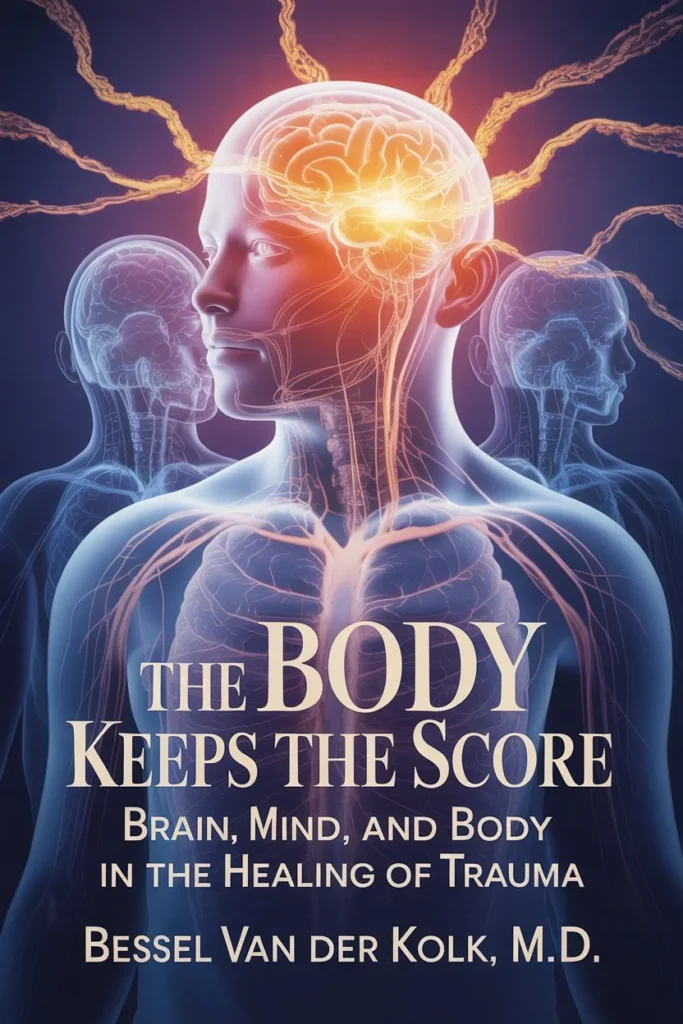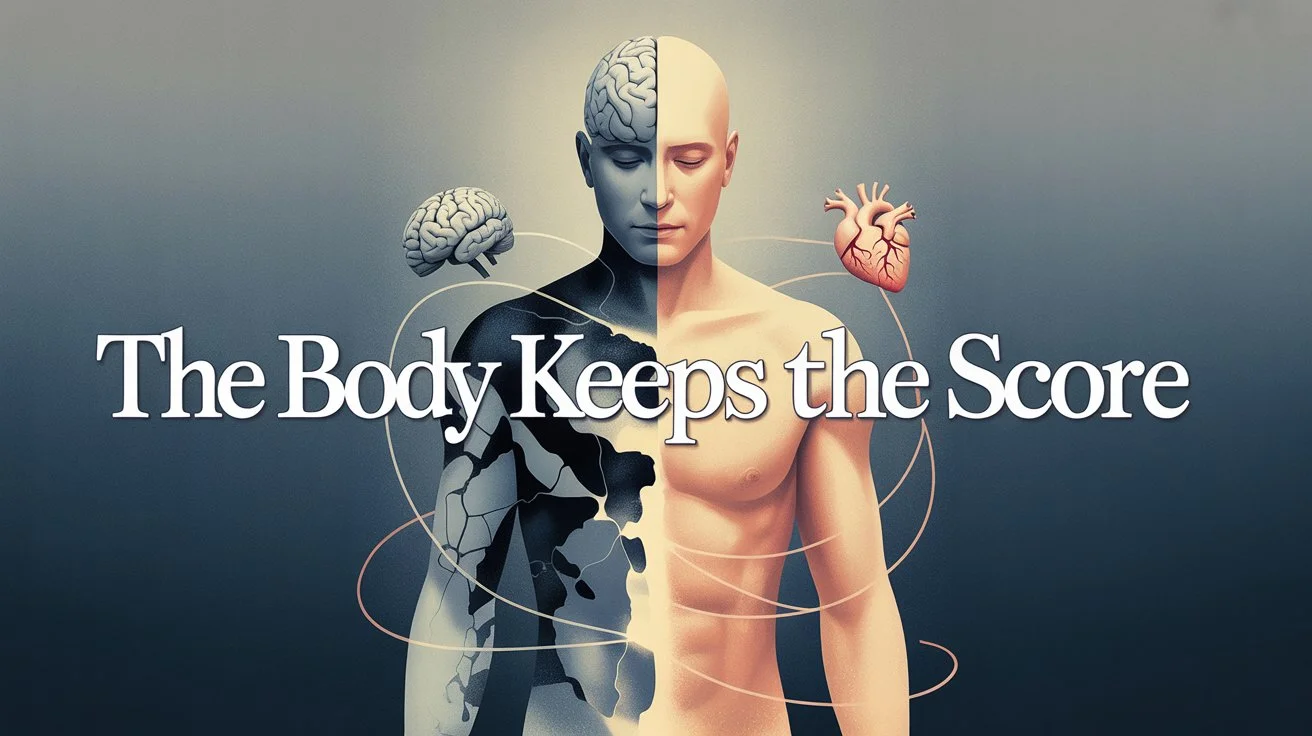The Body Keeps the Score: How Trauma Hides in Your Body and How You Can Heal
When Your Body Speaks the Pain Your Mind Has Buried
You know that feeling when your heart races for no reason or your chest tightens at the sound of a voice or the sight of a place you haven’t thought of in years? It’s as if your body knows something your mind forgot—or perhaps, never truly processed.

That’s not your imagination. That’s trauma. And in The Body Keeps the Score, Dr. Bessel van der Kolk explains why your body often tells the truth your memory can’t.
This isn’t just another book on mental health. It’s a wake-up call for anyone who has ever felt stuck, numb, or on edge—and never fully understood why. If you’ve wondered why traditional therapy isn’t working or why you can’t just “move on,” this is where your healing story might begin.
Table of Contents
What Is The Body Keeps the Score About?
At its core, this book bridges the gap between your physical sensations and your emotional scars. It unpacks how trauma isn’t just a memory—it’s an ongoing experience etched into your nervous system.
Book Snapshot:
| Feature | Description |
|---|---|
| Title | The Body Keeps the Score |
| Author | Dr. Bessel van der Kolk, M.D. |
| First Published | 2014 |
| Topics Covered | Trauma, PTSD, brain science, healing therapies |
| Audience | Trauma survivors, caregivers, therapists, everyday readers |
Whether you’ve experienced trauma firsthand, work with people who have, or want to understand your body better—this book lays a powerful foundation.
How Trauma Affects Your Brain and Body
You might think trauma only lives in your past. But it doesn’t. It lives in your heartbeat, your breathing, your posture—even in how you react in traffic or handle conflict.
Brain Changes You Can’t See but Definitely Feel
- Your amygdala becomes overactive, keeping you in a state of fight-or-flight.
- Your prefrontal cortex goes offline, limiting your ability to think clearly or calm yourself.
- The hippocampus—your memory processor—shrinks, making your past feel like your present.
Your mind starts confusing safety with danger, and even minor stresses become overwhelming.
Physical Symptoms You May Be Ignoring
- Chronic fatigue, migraines, muscle tension, and digestive issues.
- Sudden anger, dissociation, or panic attacks without a clear trigger.
- Emotional shutdown, difficulty trusting, or avoiding eye contact.
If you’ve ever felt like your body is sabotaging your peace, it’s more likely that it’s trying to protect you. It’s just using outdated information.
Healing Isn’t Just in Your Head—It’s in Your Body Too
You’ve probably been told to “talk it out,” and yes—words matter. But if trauma lives in your body, then healing has to include it too.
Traditional Tools: Necessary but Not Always Enough
- Talk Therapy: Great for building insight, but sometimes retraumatizing if not done right.
- Medication: Helpful in stabilizing symptoms, but not a cure on its own.
These methods can support your journey, but they often don’t get to the root stored in your tissues.
Body-Based Therapies That Help You Reclaim Safety
- EMDR (Eye Movement Desensitization and Reprocessing)
Allows your brain to reprocess trauma in a safe, structured way. - Yoga and Mindful Breathing
Reconnects you with your body, grounds you in the present moment. - Somatic Experiencing & Internal Family Systems (IFS)
Helps you listen to your body’s signals and understand your emotional parts. - Neurofeedback
Trains your brain to recognize calm again using real-time brainwave data.
You don’t just need to relive trauma to heal it—you need to feel safe while working through it.
5 Key Insights You’ll Gain from The Body Keeps the Score
Here’s what sticks with you long after the final chapter:
- Your Body Tells the Truth
Even when your mind suppresses pain, your body remembers and signals. - You Can’t Heal in Isolation
Safe relationships and compassionate support systems are key. - Survival Wasn’t Weakness—It Was Intelligence
Your coping mechanisms were brilliant adaptations, not character flaws. - Healing Is Nonlinear
It’s a winding path, not a straight line, and that’s okay. - You Deserve to Feel at Home in Your Body Again
Restoration is possible—not just for your mind, but your nervous system.
Why This Book Still Matters—Now More Than Ever
In a world that’s only just beginning to understand trauma, this book is a lighthouse.
Post-Pandemic Trauma Is Real
Isolation, loss, and collective uncertainty have left invisible wounds. People are anxious, hypervigilant, and emotionally exhausted—and they often don’t know why.
Changing the Narrative Around Healing
We’re slowly moving from “What’s wrong with you?” to “What happened to you?”
And that shift matters. It removes shame. It invites understanding. It creates space for your nervous system to breathe.
Dr. van der Kolk doesn’t just offer information. He offers validation—something that often starts your healing long before therapy begins.
The Body Keeps the Score: What Works and What Doesn’t
What Makes This Book Powerful
- Science Meets Storytelling
It’s rooted in research but told through real-life cases and human emotion. - Holistic Approach
It respects both psychology and physiology. - Empowering
You walk away feeling informed—not broken.
What to Watch Out For
- Dense at Times
The neuroscience can be technical; some sections require slow reading. - Not a Quick Fix
It’s not a self-help book in the traditional sense—it’s a paradigm shift.
Is This Book Right for You?
You Should Absolutely Read It If:
- You’ve experienced any form of trauma, big or small.
- You want to understand why you react the way you do.
- You’re a therapist, caregiver, or teacher working with vulnerable people.
- You’ve tried therapy but still feel stuck.
It Might Not Suit You If:
- You’re looking for a light or fast read.
- You’re uncomfortable with scientific terms or clinical stories.
- You’re hoping for a “10 steps to healing” guide—this isn’t that.
Frequently Asked Questions About The Body Keeps the Score
Is The Body Keeps the Score hard to read?
A: It can be emotionally intense and scientifically detailed, but it’s written with compassion and clarity. Taking breaks helps.
Will this book cure my trauma?
A: No book can do that—but it can validate your experience, educate you, and guide you toward effective treatment options.
Do I need a therapist to understand the content?
A: Not necessarily. While a therapist can help you apply the concepts, you can read and absorb the material at your own pace.
What makes this book different?
A: It uniquely combines cutting-edge neuroscience with real human stories and shows you how healing happens not just through talk, but through the body.
Summary Table: What You Learn from The Body Keeps the Score
| Section | What You Learn |
|---|---|
| Brain & Body Connection | How trauma disrupts brain function and physical health |
| Healing Techniques | Why talk therapy isn’t enough—and what else works |
| Key Insights | Practical, profound truths that change how you view your symptoms |
| Pros & Cons | The book’s strengths and limitations |
| Reader Suitability | Who should (and maybe shouldn’t) read it |
Final Thoughts: Your Body Knows the Way—Listen
Here’s the truth: trauma doesn’t have to define your future. You’ve survived. Now it’s time to reclaim.
The Body Keeps the Score is more than a title—it’s an invitation. An invitation to stop fighting your body and start listening to it. Because within those racing heartbeats, clenched jaws, and frozen reactions is a map. A way back to safety. To trust. To wholeness.
Your Next Step?
- Buy the book.
- Take notes.
- Read slowly.
- Most importantly—be kind to yourself along the way.
Ready to Start Healing?
If you found yourself nodding while reading this, it’s not by accident. Trauma is real. So is recovery. Start with The Body Keeps the Score. Your body’s been waiting for you to come back home.

